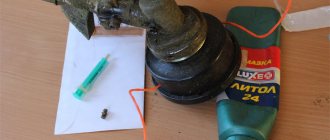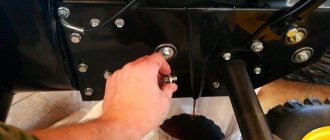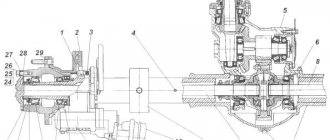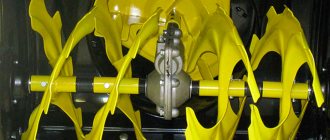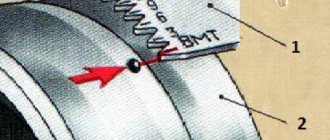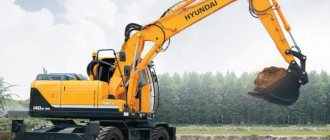In this article you will become familiar with the process of lubrication of an electric saw chain. Let's look at what electric saw oil is used for various materials today, look at the lubricant supply device for the chain, and briefly outline the main elements involved in this process. Let's get acquainted and consider the features of using various brands of oils for electric saws. Here you will receive small tips and warnings on the maintenance and operation of this tool.
How to choose the right chain for an electric saw?
When faced with replacing saw parts, users wonder which chain is best for power saws. Focus on the purposes for which you use this tool, as well as the compatibility of accessories for other brands:
- If power is important to you, choose a chain with a large pitch electric saw. If the loads are relatively small, then a smaller chainsaw pitch is sufficient, and the volume of the cylinder does not matter.
- Taking into account the sharpening angle of the chain of the electric saw used, this figure is important for further maintenance, repair or replacement. An angle of thirty degrees will provide maximum performance as it can better withstand heavy loads. A ten degree angle is suitable for handling raw or frozen material.
- The length of the chain should correspond to the parameters of the tire, do not worry if it stretches or bends during use, as this can be easily removed by removing a couple of links.
In order to select a chain for an electric saw as accurately as possible, in addition to the technical characteristics of the equipment, you must take into account the cutting method, as well as the materials being processed. If a rip cut is required, it is recommended to use a chain saw with a minimum sharpening angle; in this case, productivity may be lower, but service life will be significantly increased.
Electric chain saw Makita UC 3520A Review
In this video
I'm reviewing my Makita
UC 3520A.
In the video
I partially disassemble the saw casing,
The flap-shaped lever in front of the handle is a chain brake. The man throws a punch, he leans his hand on the flap, the engine stops. This is anti-reverse protection.
The Makita electric chain saw has a motor overheating lock and a switch-on lock. A smooth increase in starting current allows you to gradually gain momentum, extending the service life of all components.
Experts advise not to buy a saw if it is not locked. This is the first sign that the model is fake.
showed that Makita saws rank first in the Yandex Market rankings based on user surveys and product purchases.
https://youtube.com/watch?v=grQnNG8cifE
How to put a chain on a chainsaw?
It is worth noting that tool manufacturers do not prohibit self-service of the tool, and also provide instructions on how to remove and install the chain on a chainsaw. If we consider one of the most common types, where the chain tension on the chainsaw is lateral, the algorithm looks like this:
- Move the shield, protecting it, releasing the brakes.
- Use a screwdriver to turn the tension control screw.
- Tighten the nut until the tension is released.
- Remove the cover.
- You will need to separate the wheel and chain from the sprocket.
- You will need to remove the old chain from the bar and replace it with a new one.
- Now all previous manipulations are performed in reverse order.
- The chain should be tightened smoothly, without jerking.
- By closing the plastic cover, you can finally tighten the nut and screw of the electric saw chain.
READ Ripping Chainsaw Chain
Manufacturers of power tools are constantly modernizing their devices, so new devices appear that significantly simplify all processes associated with the operation and maintenance of units. Today, power saws come equipped with a variety of chain tensioners, often using surgical wing nuts.
Classification of oils that are suitable for use
For work, you need to use only oils that contain useful antioxidant, anti-corrosion and stabilizing components that prevent premature failure of chainsaw parts. The working conditions of the saw set are quite difficult, so it is advisable to choose only high-quality oils for your tool. Leading manufacturers in this area are Shtil, Bosch, Husqvarna, Daewoo and others. Chinese manufacturers are not much inferior to the leaders in this area, as they have recently begun to monitor the quality of the product they produce. When choosing oil, it is advisable to focus on the climatic conditions in which the saw will operate.
You need to purchase oil for two-stroke engines, which is sold in specialized stores. There are 2 types:
- Mineral;
- Synthetic.
CHAMPION adhesive oil for chain lubrication
Synthetic oil is more expensive and this is what experts recommend using. Synthetic oil prevents the formation of carbon deposits and increases tool life.
When choosing, pay attention to the viscosity indicator, which may differ for the operation of the unit at different times of the year. For the summer period, it is best to use oils with a viscosity type of 15-40, and for the winter period - 10-30
Brand M8 or M10. It is advisable to always use the same brand, as this allows you to better study the features of the saw.
How to make the mixture correctly
Many experts use self-prepared mixtures
In this case, it is important to follow the instructions and maintain the proportions. Usually the oil is diluted with gasoline in a ratio of 1:50 or 1:40
Gasoline is used only by A-92 and A-95. It is better to use fresh gasoline to prevent damage. Use the oil only for two-stroke engines of API-TB and API-TC classes. The finished mixture cannot be stored for a long time. The ideal option is to prepare a certain amount and use it within a month.
How to sharpen an electric saw chain with your own hands?
Like any tool, an electric saw can become ineffective over time, as woodworking outshines even the sharpest and most durable materials. Depending on the degree of intensity, the time for sharpening an electric saw chain with your own hands may vary. If individual saw chain teeth are not sharpened in time, they will not only lose their original shape and become unusable, but will also require a complete chain replacement. As soon as you see signs of dullness, you need to take the appropriate action by sharpening your electric saw chain.
Characteristics
Keep in mind that sharpening a chain with a chainsaw should be done as carefully as possible, unless you are confident that a file and a couple of strokes are enough to adjust the cutting edge, this is not the case. You will need a set of at least four tools:
- Caliber.
- Use a flat file to change depth sensor settings.
- Round file with landmarks.
- Frame for determining the angle.
If you have doubts about sharpening a chain on a chainsaw, leave it to a professional, but most users have no problem with this problem because you should leave the chain in the bar, securing the bar with a vise, for a secure fit and easy access to the links. Please note that the file diameter must match the teeth.
Sharpening equipment
There are more efficient ways to sharpen electric saw chains; Manual and electric machines are used for this purpose. Power plants require access to an energy source, but at the same time have many advantages, in particular:
- Ability to work with different chains on electric saws.
- You can adjust the cutting depth and height.
- Creating a limiter as accurately as possible.
- You can set the cutting angle you want.
Useful tips
It is important to keep in mind that as the engine speed increases, the rate of pumping of the lubricant also increases noticeably. That is why it is necessary to pour the oil mixture into an electric saw only when the engine is turned off.
Lubricating compounds for electric saw chains should be purchased exclusively at specialized retail outlets. Only such products are of high quality and effective. You should not purchase goods at markets or street shops. Most likely, they will sell you a fake, which will not only be useless, but will also lead to damage to the instrument.
There are a lot of oils on sale. But the best option is oil with good adhesive properties. Such products contain special additives. Thanks to the latter, the composition does not shake off or flow off the chain of the electric saw as it actively rotates. Only such a remedy will be effective and will have a beneficial effect on the condition of the instrument.
How to choose oil for an electric saw, learn from the video below.
How to extend the life of a chain?
To sharpen or replace chains as little as possible, use the tool as intended. Make sure there are no foreign objects on the wood, such as metal staples, bolts, or nails. In addition, it is very important that the saw chain does not come into contact with the ground; special cutting supports are useful. Compliance with the interval mode to avoid overheating and timely lubrication of the chain on electric saws will significantly increase the service life of electrical equipment.
Source
One of the important chainsaw systems, without which it is impossible to work, is the forced lubrication system for chainsaw chains. It is no secret that during operation of the saw, the chain on the chain saw wears out, which leads to its premature heating and wear. The chain mechanism must be constantly lubricated to reduce friction.
READ Husqvarna Chainsaw Chains Not Lubricated
Review of brands from various manufacturers
There are many attractive offerings on the market today from a wide range of specialty oil manufacturers that can cope with high temperatures while still providing excellent gear lubrication performance. The most popular of them are presented in the following list.
- Forest Plus has high adhesive properties and can be used at ambient temperatures up to fifteen °C. Under certain conditions, the oil has a shelf life of three years. Sold in 1-liter and 5-liter packages. Cost one liter. Three hundred thirty rubles, five liters. One thousand one hundred and forty rubles.
- Plant-based Bio Plus products. It decomposes quickly when released into the soil. The oil can be used at temperatures up to 15C. Packaging one and 5 liter container. Cost one liter. Three hundred sixty rubles.
- Synth Plus is made on a synthetic base. Withstands increased loads and can be used at especially low temperatures down to 25C. Packaging one and 4 liter container. Cost one liter. Seven hundred ninety rubles, 4l. Two thousand nine hundred seventy rubles.
- CHAMPION adhesive is designed to work in a wide temperature range. It is sold in 3 and 10 liter containers, which is very convenient for use in forestry. Cost 3l. Four hundred ninety rubles, ten liters. Two thousand two hundred rubles.
- HUSQVARNA Vegoil. one of the most economical solutions for lubricating electric saws. According to the manufacturer, the consumption of this material is 40% less than others. Cost one liter. Three hundred ninety rubles.
Using special oil to lubricate the chain mechanism of an electric saw will ensure its smooth operation for a long time. This will allow the job to be completed quickly, efficiently and with a high level of safety, which will ultimately lead to significant savings on the repair and maintenance of the entire tool.
Chainsaw lubrication system
To supply oil for lubricating chainsaw chains, the tool uses a special pump, which is dosed, depending on the engine speed, and supplies oil to the saw bar.
The system uses oil to lubricate the chainsaw chain, which has improved adhesive properties, this is necessary to distribute the oil evenly around the perimeter of the bar and retain it even at high chain speeds. Let's take a closer look at the oil supply system implemented in modern chainsaws.
Have you encountered such a problem? What to do?
We have already repaired electric saws and eliminated the defect of no oil flowing to the chain. This malfunction can be treated by service engineers at any Umedia service centers. The price for repairs without parts is 1,500 rubles. Diagnostics with analysis at the service center is free. The terms of this service are minimal. Has your equipment stopped working? What to do? — Bring it to any one of 21 Umedia services and we will fix it!
Lubrication system design
Depending on the brand of chainsaw, the parts of the lubrication system may differ slightly in design, but their total number and connection diagram remain unchanged.
The main components of the lubrication system are:
- The oil tank is usually located in the crankcase.
- The filter element is installed in the tank.
- The oil pipe is a small-diameter hose made of oil-resistant rubber.
- The heart of the system is the oil pump.
- The worm gear transfers power from the motor to the pump.
- The chainsaw bar can also be considered an element of the lubrication system, since it has special holes for supplying oil; by the way, the chain itself is involved in transporting the oil and, accordingly, also has some elements designed specifically to provide lubrication.
Operating principle
The main unit of the system is the pump. The principle of its operation is as follows. As engine speed increases, a gear mounted on the main shaft moves the pump shaft through a worm gear. In turn, the rotation of the shaft creates a certain pressure in the oil line, as a result of which the oil moves along it towards the tire.
The end of the oil channel is located where the tire touches the body of the tool, where there is a longitudinal groove into which its oil channel fits when the tire is installed.
The groove is necessary to ensure the supply of oil to the tire, regardless of the degree of tension of the chainsaw chain. Simply put, no matter what position the tire is in while running, oil will flow through it through the groove.
Then the chain is included in the lubrication process, on the links of which, depending on the chain model, there is either a groove or a hole through which the oil is dispersed throughout the tire. As the engine speed increases, the oil flow rate also increases.
Some chainsaw models are equipped with pumps with additional power control, and if necessary, the amount of oil supplied by the lubrication system can be increased or decreased.
This function is quite convenient because it allows you to save rather than waste extra oil.
What kind of oil should be poured into an electric saw?
For most owners of electric saws, it is no big secret that the oil used to lubricate the electric saw chain is one of the main consumables. However, not everyone pays due attention to the quality of the lubricant. And it is completely in vain, since the life of its further operation will depend on how well this product lubricates the working surface of the chain. Therefore, before pouring oil into an electric saw, you need to pay attention to its technical characteristics.
Why is it necessary to lubricate the chain on an electric saw?
Electric saw oil is used as a chain lubricant to neutralize frictional forces and reduce heat generation. As a result, fast and uninterrupted operation of the cutting blade is achieved. Sometimes it happens that at some stages of cutting it is necessary to make additional efforts to obtain the required cut, and this directly indicates an insufficient amount of lubricant or its not very good quality. In this case, it is recommended to immediately check the oil level in the reservoir or simply lubricate the chain to complete the current work.
Most new models of electric chain saws have a built-in automatic oil supply system to the surface of the cutting element, and manual lubrication is only necessary for older equipment.
Main components of the lubrication system
Typically, oil enters the chain lubrication system of an electric saw from a special tank, where it is periodically added. From there it is pushed out by a powerful oil pump, doing this at certain time intervals sufficient to expend the previous injection. The main task of the oil mechanism is to prevent the occurrence of such situations when the lubrication on the chain becomes insufficient, and as a result, severe overheating of the cutting part may occur due to sharply increased friction forces. As a result, the chain may become dull and fail. Therefore, the oil must be constantly monitored. Typically, the lubrication system of an electric saw consists of the following components:
- oil tank for chain lubrication;
- special oil filter;
- oil line, which is a small rubber hose that serves to supply oil from the tank;
- an oil pump that pumps lubricant from the tank to the cutting mechanism;
- a special gear with the help of which force is transmitted to the pump from the electric saw motor.
A tire could also be added to this list, since it has special holes for oil supply.
Operating principle of the chain lubrication system
As already mentioned, the main link in the lubrication system is the pump. It works like this. When the engine speed increases, the gear, which is located on the main shaft, begins the pump operation process through a transmission. At this moment, the pressure in the oil supply system increases, and it begins to move towards the tire. This movement ends where the saw housing comes into contact with the tire, in the very place where the longitudinal groove is located, to which the oil channel itself is directed when mounting the tire. This groove is required to supply lubricant to the tire at any tension level of the chain mechanism, i.e. Regardless of the position of the bar during operation of the electric saw, the groove will ensure the supply of lubricant to it. The next feed link is the chain itself. Its links have their own separate groove or hole through which the material is distributed along the length of the chain.
Electric saw chain automatic lubrication system
If the engine speed increases, the lubricant pumping speed also increases. Therefore, it is recommended to pour oil into the electric saw only when the engine is turned off.
Many modern models of electric saws, for example, Makita, have built-in pumps with additional skip adjustment, with which you can regulate the amount of lubricant supplied. In older modifications of saws this feature is usually missing. There, the oil supply is carried out in a constant and unchangeable mode or, as in the very first models, the user has to lubricate the chain manually. Those who own outdated copies need to know how to properly lubricate the chain mechanism by hand. It's not difficult at all:
- take any old container and fill it with oil;
- the chain mechanism is carefully immersed in this container.
These actions should be carried out periodically as the lubricant on the chain is used up.
Consequences of lack or excess of lubrication on the chain
For each mechanism whose operating mode is associated with lubricant based on machine oil, certain parameters must be observed. This primarily concerns the amount of oil required for its normal operation. The following problems may occur if there is not enough oil:
- circuit overheating;
- premature dulling of cutting teeth;
- chain jamming or breaking;
- additional time spent on cutting;
- increased sprocket wear;
- tire failure.
For an electric chain saw, it is recommended to fill the oil tank in the following proportion: one full filling of oil per full filling of the gas tank, i.e. 1:1. In some models, for example, Bosh, the lubrication system operates in a fully automatic mode and, if there is too much or little oil on the chain, the saw itself begins to regulate its supply. However, if a malfunction occurs and oil literally begins to pour from the chain mechanism, then its excess can lead to the following undesirable consequences:
- increased oil consumption;
- excessive contamination of the instrument body;
- wide emission of oil splashes from the chain.
Lubrication system malfunctions and ways to eliminate them
The main malfunctions of the oil supply system to a chainsaw can be divided into two main types: these are general malfunctions inherent in all chainsaws, and individual ones, which can vary depending on the type of pump and worm gearbox installed on a particular model. Let's start sorting out the faults in order.
Signs of a malfunction of the lubrication system, checking its performance
- The chainsaw chain is dry and has a pale tint without shine.
- The chain stretches relatively quickly.
- The tire is very hot and may even partially melt the paint.
- The oil from the tank practically does not decrease.
- Efficiency of a sharp section of a chain
All these signs indicate that the lubrication process is not normal. To check the oil supply to the lubrication system, remove the side guide of the chainsaw and start it. Next, you need to slightly increase the speed, keeping an eye on the end of the oil line. If oil has entered, there is likely not enough oil to provide proper lubrication and you will need to clean or replace the filter and adjust the flow if possible. If this does not happen, the problem is more serious and requires further diagnosis.
READ How to Sharpen a Wood Saw
There is a way to check the oil supply without removing the tires. To do this, point the end of the bar towards the side, for example, freshly cut stones on the cut side and maximize speed, while trying to keep the end of the bar no more than 10 cm away from the cutlet. If greasy spots begin to appear on its surface, then oil is supplied.
Problem solving
Once it has been determined that no oil is being supplied, further diagnosis is only possible if the oil system is completely removed. Of course, replacing filters helps in some situations, but this is very rare.
The most common faults
- Broken oil hose. Sometimes this can be found during a visual inspection. The problem is solved by replacing the faulty part.
- Missing threads on the oil pump shaft will help replace it.
- Defective threads on the pump drive can also be eliminated by installing a new part.
- There is no main shaft corkscrew (this is true for some instrument models, such as Homelite). You can fix this by installing a corkscrew that matches the diameter of the carnation in place of the original corkscrew, cutting it to the required length.
- Lock track. It can be removed by blowing with compressed air or mechanically using a wire of the appropriate diameter.
- The filter element is clogged.
- Stihl MS 180, the pump of which cannot be disconnected, often clogs. You can try flushing with pure gasoline if that doesn't help replace it.
- Chinese chainsaws (Gypsies) often have grooves cut out on the main gear, through which it is transmitted to the power of the star.
Malfunction of the individual lubrication system Stihl MS 180
Due to the fact that the Stihl MS 180 is one of the most common models of chainsaws, I would like to dwell on one of its malfunctions and describe how to fix it without replacing parts.
Often, on the Stihl MS 180 chainsaw, the oil pipeline depressurizes in the place where, in the case of the saw, the oil pipeline coming from the tank is installed. The malfunction can be identified by characteristic points on the bottom of the tool.
To troubleshoot, remove the chainsaw handle, remove the hose from the hole, clean and degrease. After all these manipulations, apply sealant to the hose seat and install the chainsaw into the body.
You can learn more about troubleshooting and fully diagnosing the lubrication system of a Stihl chainsaw by watching a video that shows the step-by-step process of disassembling and repairing the lubrication system.
Possible reasons for fuel failure
Oil to the chain only if there are two breakdowns. These include:
- problems with air leaks;
- failure of the oil pump .
Basic parameters of a chainsaw chain.
The main cause of failure is air leaks. This can happen due to depressurization of the oil hose while using the chainsaw. In this case, it is necessary to remove the hose from the hole. This must be done in the place where it is connected to the crankcase. Then the hose is seated on the sealant and installed in its usual position. If this doesn't help, there's likely been a loss of elasticity. For further operation of the chainsaw, it is advisable to replace the hose.
The second reason is a breakdown of the oil pump . In common parlance this part is called a worm. When the drive fails, oil will stop flowing to the chain . The oil pump drive is a round plastic ring with grooves inside. Constant use of a chainsaw leads to wear of the internal parts, resulting in the metal hook located inside the drive being chipped. After this breakdown, oil stops flowing to the chain .
